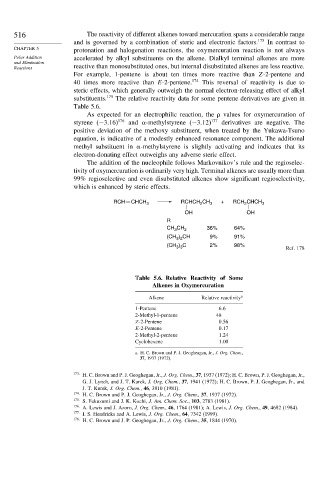Page 535 - Advanced Organic Chemistry Part A - Structure and Mechanisms, 5th ed (2007) - Carey _ Sundberg
P. 535
516 The reactivity of different alkenes toward mercuration spans a considerable range
and is governed by a combination of steric and electronic factors. 173 In contrast to
CHAPTER 5 protonation and halogenation reactions, the oxymercuration reaction is not always
Polar Addition accelerated by alkyl substituents on the alkene. Dialkyl terminal alkenes are more
and Elimination
Reactions reactive than monosubstituted ones, but internal disubstituted alkenes are less reactive.
For example, 1-pentene is about ten times more reactive than Z-2-pentene and
40 times more reactive than E-2-pentene. 174 This reversal of reactivity is due to
steric effects, which generally outweigh the normal electron-releasing effect of alkyl
substituents. 175 The relative reactivity data for some pentene derivatives are given in
Table 5.6.
As expected for an electrophilic reaction, the
values for oxymercuration of
styrene (−3 16) 176 and -methylstyrene (−3 12) 177 derivatives are negative. The
positive deviation of the methoxy substituent, when treated by the Yukawa-Tsuno
equation, is indicative of a modestly enhanced resonance component. The additional
methyl substituent in -methylstyrene is slightly activating and indicates that its
electron-donating effect outweighs any adverse steric effect.
The addition of the nucleophile follows Markovnikov’s rule and the regioselec-
tivity of oxymercuration is ordinarily very high. Terminal alkenes are usually more than
99% regioselective and even disubstituted alkenes show significant regioselectivity,
which is enhanced by steric effects.
RCH CHCH 3 RCHCH 2 CH 3 + RCH CHCH 3
2
OH OH
R
CH 36% 64%
CH 3 2
(CH ) CH 9% 91%
3 2
(CH ) C 2% 98% Ref. 178
3 3
Table 5.6. Relative Reactivity of Some
Alkenes in Oxymercuration
Alkene Relative reactivity a
1-Pentene 6 6
2-Methyl-1-pentene 48
Z-2-Pentene 0 56
E-2-Pentene 0 17
2-Methyl-2-pentene 1 24
Cyclohexene 1 00
a. H. C. Brown and P. J. Geogheagan, Jr., J. Org. Chem.,
37, 1937 (1972).
173
H. C. Brown and P. J. Geoghegan, Jr., J. Org. Chem., 37, 1937 (1972); H. C. Brown, P. J. Geoghegan, Jr.,
G. J. Lynch, and J. T. Kurek, J. Org. Chem., 37, 1941 (1972); H. C. Brown, P. J. Geoghegan, Jr., and
J. T. Kurek, J. Org. Chem., 46, 3810 (1981).
174 H. C. Brown and P. J. Geoghegan, Jr., J. Org. Chem., 37, 1937 (1972).
175
S. Fukuzumi and J. K. Kochi, J. Am. Chem. Soc., 103, 2783 (1981).
176
A. Lewis and J. Azoro, J. Org. Chem., 46, 1764 (1981); A. Lewis, J. Org. Chem., 49, 4682 (1984).
177 I. S. Hendricks and A. Lewis, J. Org. Chem., 64, 7342 (1999).
178
H. C. Brown and J. P. Geoghegan, Jr., J. Org. Chem., 35, 1844 (1970).

